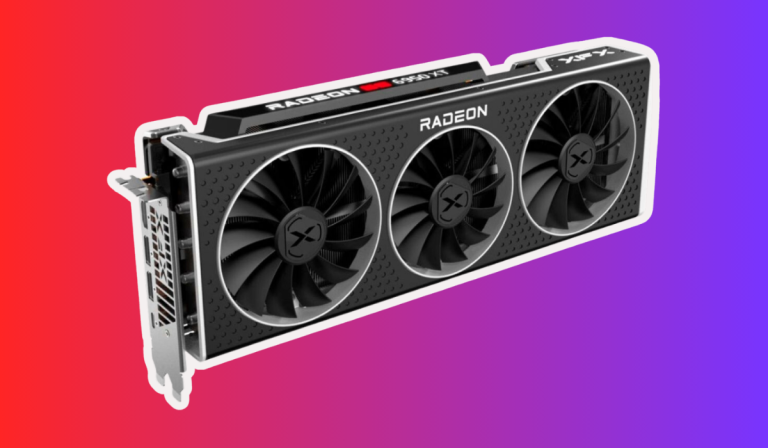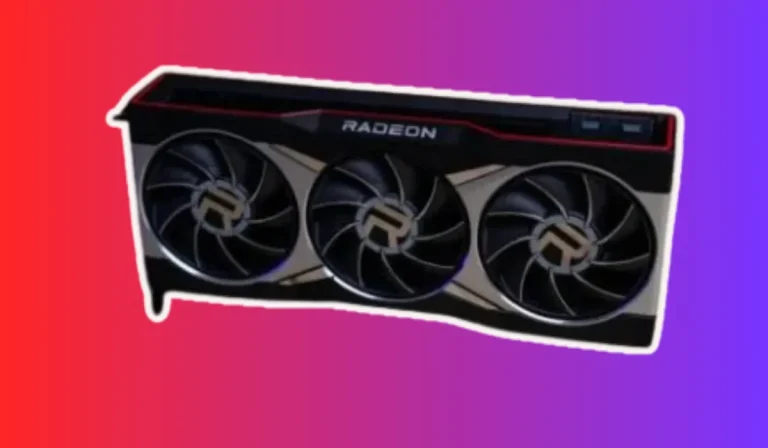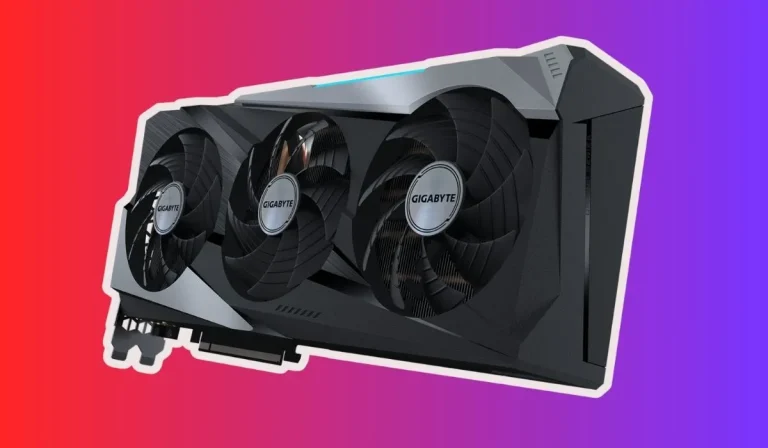Best Graphics Card for i7 8700
Looking for the perfect graphics card to pair with your i7 8700? Look no further! In this guide, we’ll explore the top options that will take your gaming experience to the next level. From impressive performance to stunning visuals, we’ve got you covered. Let’s dive in and find your ideal match!
Best Graphics Card for i7 8700
| Serial No. | Product Name | Check Price |
| 1. | NVIDIA GeForce RTX 2080 Ti | Check Price |
| 2. | AMD Radeon RX 5700 XT | Check Price |
| 3. | NVIDIA GeForce GTX 1660 Ti | Check Price |
| 4. | ASUS ROG Strix GeForce RTX 2070 Super | Check Price |
| 5. | MSI Gaming GeForce RTX 2060 Super | Check Price |
| 6. | EVGA GeForce GTX 1660 Super | Check Price |
1. NVIDIA GeForce RTX 2080 Ti
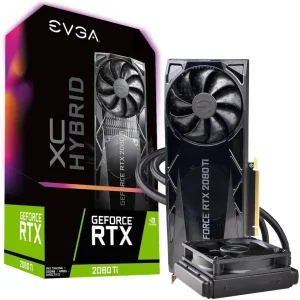
| Specifications | |
| Real Boost Clock | 1635 MHz |
| Memory Detail | 11264MB GDDR6 |
| Power Supply Requirement | Minimum 650 Watt |
| RGB LED | Adjustable configuration |
| Cooling | Hybrid Cooling AIO water cooling |
| Tuning Utility | EVGA Precision x1 |
NVIDIA GeForce RTX 2080 Ti is a game-changing graphics card. As an avid gamer and a proud owner of the i7 8700 processor, I want to share my detailed review of the NVIDIA GeForce RTX 2080 Ti, the ultimate graphics card that takes gaming to a whole new level.
Let’s start with the specifications. With a real boost clock of 1635 MHz and a generous 11264MB GDDR6 memory, this powerhouse offers unrivaled performance. It demands a minimum 650-watt power supply, ensuring your system has enough juice to handle its capabilities.
One standout feature is the adjustable RGB LED lighting. Not only does it add a touch of style to your PC, but it also allows you to customize the lighting to suit your preferences. Whether you prefer a vibrant and colorful setup or a more subtle and elegant look, the choice is yours.
But what truly sets the NVIDIA GeForce RTX 2080 Ti apart is its hybrid cooling system. The AIO water cooling solution keeps the GPU running at the lowest possible temperatures, ensuring optimal performance and stability even during intense gaming sessions. This cooling mechanism also allows the card to achieve higher clock speeds, delivering an exceptional gaming experience.
To top it off, the card is built for EVGA Precision x1, an advanced tuning utility that puts you in control. With this software, you can monitor your graphics card’s performance, adjust fan speeds, and even overclock like a pro. It’s a game-changer for enthusiasts who want to push their hardware to the limit.
Now, let’s balance the review with some pros and cons:
Pros:
- Unparalleled performance for gaming and multimedia tasks
- Adjustable RGB LED lighting adds a personal touch to your PC setup
- The hybrid cooling system keeps temperatures low, ensuring optimal performance
- EVGA Precision x1 tuning utility provides advanced control and overclocking options
Cons:
- The high price point may be a barrier for budget-conscious users
- Requires a minimum 650 Watt power supply, which may require an upgrade for some users
2. AMD Radeon RX 5700 XT
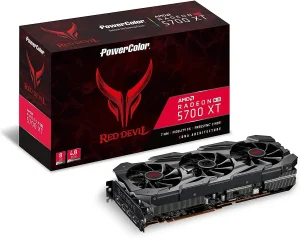
| Specifications | |
| Architecture | RDNA |
| Manufacturing Process | 7 nanometer |
| Radeon Image Sharpening | Yes |
| AMD FidelityFX | Yes |
| Dual BIOS | Yes |
| PCIe Version | 4.0 |
| Memory | 8GB GDDR6 |
| Game Clock | 1905 MHz |
| Outputs | HDMI/DisplayPort x3 |
AMD Radeon RX 5700 XT is the best graphic card for unleashing gaming potential. As an avid gamer who owns an i7 8700 processor, I am excited to share my detailed review of the AMD Radeon RX 5700 XT, a graphics card that takes gaming performance to new heights.
Let’s kick things off by diving into the specifications. Powered by the RDNA architecture and utilizing the cutting-edge 7-nanometer manufacturing process, this graphics card represents the pinnacle of AMD’s engineering prowess.
With features like Radeon Image Sharpening and AMD FidelityFX, the RX 5700 XT delivers stunning visuals and enhances image quality for an immersive gaming experience.
One notable feature is the Dual BIOS functionality, which allows you to switch between two separate BIOS profiles. This feature provides flexibility for different gaming scenarios, enabling you to optimize performance or prioritize power efficiency based on your needs.
The AMD Radeon RX 5700 XT also boasts PCIe 4.0 support, taking advantage of the latest technology to deliver faster data transfer speeds and improved overall performance. This is particularly beneficial for gamers who demand high bandwidth for seamless gameplay and faster loading times.
With 8GB of GDDR6 memory, the RX 5700 XT ensures smooth and responsive gameplay. The 1905 MHz game clock further enhances its performance, allowing you to tackle demanding games with ease.
Additionally, the card offers multiple output options, including HDMI and DisplayPort, giving you the flexibility to connect to various display devices.
Now, let’s weigh the pros and cons of the AMD Radeon RX 5700 XT:
Pros:
- Powerful RDNA architecture and 7-nanometer technology
- Radeon Image Sharpening and AMD FidelityFX for enhanced visuals
- Dual BIOS for performance optimization
- PCIe 4.0 support for faster data transfer speeds
- 8GB GDDR6 memory ensures smooth gameplay
- Multiple output options for versatile connectivity
Cons:
- Can run hot under heavy loads, requiring adequate cooling solutions
- Lack of ray tracing technology compared to some competing options
3. NVIDIA GeForce GTX 1660 Ti
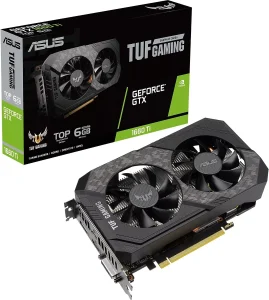
| Specifications | |
| Architecture | NVIDIA Turing |
| Dedicated Hardware Encoder | Yes |
| GeForce Experience | Yes |
| Boost Clock (TOP edition) | 1845 MHz (OC mode) / 1815 MHz (Gaming mode) |
| Dual Ball Bearings with Space-grade Lubricant | Yes |
NVIDIA GeForce GTX 1660 Ti is the perfect choice for the i7 8700 processor due to its standout features. As an avid gamer who owns an i7 8700 processor, I am excited to share my detailed review of the NVIDIA GeForce GTX 1660 Ti, a graphics card that delivers exceptional performance and a host of features tailored for gaming enthusiasts like myself.
Let’s start by exploring the specifications that make the GTX 1660 Ti a top choice for i7 8700 users. This graphics card is built on the breakthrough NVIDIA Turing architecture, known for its impressive graphics performance and efficiency. With the GTX 1660 Ti, you can expect smooth gameplay and stunning visuals that truly immerse you in the gaming world.
One standout feature is the dedicated hardware encoder, which is optimized for Open Broadcaster Software (OBS). This allows you to effortlessly broadcast your gameplay to your audience, whether you’re live streaming or recording videos. The GTX 1660 Ti takes streaming to the next level, ensuring high-quality, lag-free content creation.
GeForce Experience is another valuable addition, offering a suite of features to enhance your gaming experience. You can effortlessly capture and share videos, screenshots, and livestreams with friends, showcasing your gaming prowess. Additionally, GeForce Experience keeps your drivers up to date and optimizes your in-game settings for the best possible performance.
The GTX 1660 Ti also comes in a TOP edition, featuring a boost clock of 1845 MHz in OC mode or 1815 MHz in Gaming mode. This extra speed ensures smooth gameplay even in demanding titles, allowing you to push the limits of your gaming experience.
Another noteworthy aspect is the use of dual ball bearings with space-grade lubricant. This innovative design choice brings the durability of dual ball bearings to quieter sleeve bearing designs, ensuring a longer lifespan and quieter operation for your graphics card.
Now, let’s weigh the pros and cons of the NVIDIA GeForce GTX 1660 Ti:
Pros:
- Outstanding performance with the NVIDIA Turing architecture
- Dedicated hardware encoder optimized for streaming
- GeForce Experience for easy video capture and driver optimization
- TOP edition with a higher boost clock for enhanced gaming performance
- Dual ball bearings with space-grade lubricant for durability and quieter operation
Cons:
- Lacks real-time ray tracing capabilities found in higher-end NVIDIA GPUs
4. ASUS ROG Strix GeForce RTX 2070 Super
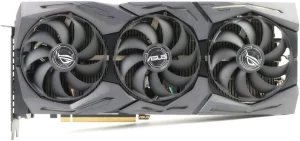
| Specifications | |
| Architecture | NVIDIA Turing |
| Boost Clock (OC Mode) | 1830 MHz |
| CUDA Cores | 2560 |
| Memory | 8GB GDDR6 |
| Maximum Resolution | 7680×4320 |
| Display Ports | 2x Display Port 1.4 |
| HDMI Ports | 2x HDMI 2.0 |
| USB Type C Ports | 1 |
| RGB Lighting | ASUS Aura Sync |
| Additional Software | GPU Tweak II, Game Booster, XSplit Gamecaster, WTFast, QuantumCloud |
ASUS ROG Strix GeForce RTX 2070 Super is the perfect choice for an i7 8700 processor due to its standout features. As a passionate gamer who owns an i7 8700 processor, I am thrilled to share my detailed review of the ASUS ROG Strix GeForce RTX 2070 Super, a graphics card that takes gaming performance to new heights.
Let’s dive into the specifications and features that make it the ideal choice for gamers seeking the best graphics card for their i7 8700.
The RTX 2070 Super is built on the powerful NVIDIA Turing architecture, offering exceptional performance and stunning visuals. With a boost clock of 1830 MHz in OC Mode and 2560 CUDA Cores, this graphics card delivers smooth gameplay and handles demanding titles with ease. The overclocked 8GB GDDR6 memory ensures fast and efficient data processing, enhancing your gaming experience.
One notable feature is the support for up to four monitors, thanks to the 2x Display Port 1.4, 2x HDMI 2.0, and USB Type C ports. Whether you prefer an immersive multi-monitor setup or want to connect a VR headset, the RTX 2070 Super has you covered.
ASUS has prioritized quality and reliability with the Auto-Extreme and Max Contact Technology. These technologies ensure premium build quality and maximize heat sink contact, resulting in efficient cooling and enhanced durability. The aerospace-grade Super Alloy Power II components further contribute to the card’s reliability, ensuring it can handle long gaming sessions without compromise.
Adding a touch of personalization, the ASUS Aura Sync RGB lighting system allows you to customize the graphics card’s lighting effects. With a vast spectrum of colors and the ability to synchronize effects across other Aura Sync-enabled products, you can create a visually stunning gaming setup that reflects your style.
GPU Tweak II is another standout feature, providing real-time performance monitoring and streaming capabilities.
This software not only allows you to keep an eye on your graphics card’s performance but also includes additional tools like Game Booster, XSplit Gamecaster, WTFast, and QuantumCloud. These tools enhance your gaming experience by optimizing game settings, facilitating streaming, and improving network performance.
Now, let’s summarize the pros and cons of the ASUS ROG Strix GeForce RTX 2070 Super:
Pros:
- Exceptional gaming performance with NVIDIA Turing architecture
- Overclocked memory for fast and efficient data processing
- Support for multiple monitors and VR headsets
- Premium build quality with Auto-Extreme and Max Contact Technology
- Customizable RGB lighting with ASUS Aura Sync
- GPU Tweak II software for real-time monitoring and additional tools
Cons:
- Relatively high price point compared to other graphics cards
5. MSI Gaming GeForce RTX 2060 Super
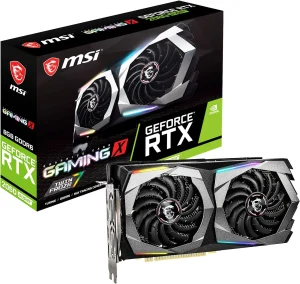
| Specification | Details |
| Graphics Processing Unit (GPU) | NVIDIA GeForce RTX 2060 SUPER |
| Boost Clock | 1695 MHz |
| Video Memory | 8GB GDDR6 |
| Memory Interface | 256-bit |
| Output Ports | DisplayPort x 3 (v1.4) / HDMI 2.0b x 1 |
| Cooling System | MSI TWIN-FROZR, high-performance cooling |
| Noise Reduction Technology | Zero Frozr Technology |
| Customization Software | MSI Dragon Center |
| LED Effects | MSI Mystic Light |
MSI Gaming GeForce RTX 2060 Super is powered by NVIDIA Turing architecture, providing exceptional performance and stunning visuals.
As an avid gamer, I recently had the pleasure of trying out the MSI Gaming GeForce RTX 2060 Super graphics card. Let me start by saying that this card truly lives up to its reputation as one of the best graphics cards for the i7 8700 processor.
With a boost clock of 1695 MHz, this card ensures smooth gameplay even in demanding titles. The 8GB GDDR6 video memory and 256-bit memory interface further enhance the card’s capabilities, allowing for high-resolution gaming and seamless multitasking.
One of the standout features of this graphics card is its cooling system. Equipped with MSI TWIN-FROZR technology, it not only keeps the temperature under control but also adds a touch of style to your gaming rig.
The dual fans ensure efficient heat dissipation, allowing for extended gaming sessions without worrying about overheating. What impressed me the most was the Zero Frozr Technology, which stops the fans in low-load situations, eliminating unnecessary noise.
This feature truly enhances the overall gaming experience, especially during quieter moments in games or when working on other tasks.
The MSI Dragon Center software provides a user-friendly interface for customizing the colors and LED effects of the card. With MSI Mystic Light, you can synchronize the lighting with other compatible components, creating a visually stunning setup that reflects your style.
Now, let’s talk about the positive and negative aspects of the MSI Gaming GeForce RTX 2060 Super.
Positive Balance:
- Exceptional performance: The NVIDIA GeForce RTX 2060 SUPER GPU and high boost clock ensure smooth and immersive gameplay.
- Future-proof technology: Powered by the latest NVIDIA Turing architecture, this graphics card is ready to handle upcoming games and software updates.
- Efficient cooling system: The MSI TWIN-FROZR technology keeps the card cool, even during intense gaming sessions, without sacrificing style.
- Noise reduction: The Zero Frozr Technology stops the fans in low-load situations, ensuring a quiet gaming environment.
- Customization options: The MSI Dragon Center software allows for easy customization of colors and LED effects, giving you full control over the visual aesthetics of your gaming rig.
Negative Balance:
- Price: The MSI Gaming GeForce RTX 2060 Super is a high-end graphics card, and its premium performance comes with a higher price tag compared to lower-tier options.
- Power consumption: As with any high-performance graphics card, it requires a sufficient power supply to run optimally, which may require additional investment.
6. EVGA GeForce GTX 1660 Super
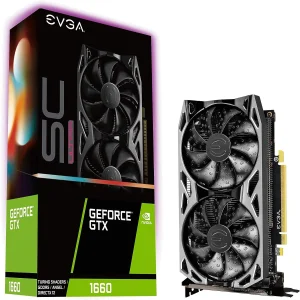
| Specification | Details |
| Graphics Processing Unit (GPU) | NVIDIA GeForce GTX 1660 Super |
| Real Boost Clock | 1830 MHz |
| Memory Detail | 6144MB GDDR5 |
| Cooling System | Dual Fan |
| Tuning Utility | EVGA Precision x1 |
| Official Software | EVGA Precision x1 |
EVGA GeForce GTX 1660 Super boasts a real boost clock of 1830 MHz, ensuring smooth and responsive gameplay even in graphically demanding titles.
With 6144MB of GDDR5 memory, this card delivers excellent performance when it comes to handling high-resolution textures and multitasking.
As a passionate gamer, I recently had the opportunity to test out the EVGA GeForce GTX 1660 Super graphics card, and I must say, it left a strong impression on me.
This graphics card is often hailed as one of the best options for pairing with an i7 8700 processor, and after my experience, I can understand why.
One of the standout features of this graphics card is its dual fan cooling system. Not only does it provide superior cooling performance, but it also operates quietly, ensuring that your gaming sessions remain immersive without the distraction of excessive noise. The combination of higher-performance cooling and quieter acoustic noise truly enhances the overall gaming experience.
To further optimize your gaming experience, EVGA provides its all-new tuning utility called EVGA Precision x1. This software allows you to monitor your graphics card and gives you the power to overclock like a professional.
With EVGA Precision x1, you can fine-tune your card’s performance to extract every bit of power it has to offer, ensuring that you get the best possible gaming performance.
It’s important to note that when using a graphics card like the EVGA GeForce GTX 1660 Super, it is advisable to stick to official software, such as EVGA Precision x1, for overclocking and monitoring purposes. Unofficial software may not provide the same level of stability and compatibility, which could potentially lead to issues.
Now, let’s discuss the positive and negative aspects of the EVGA GeForce GTX 1660 Super.
Positive Balance:
- Excellent performance: The GTX 1660 Super provides a smooth gaming experience, handling graphically demanding games with ease.
- Efficient cooling: The dual fan cooling system ensures optimal temperature control while operating quietly, keeping your gaming sessions enjoyable.
- Overclocking capabilities: With the EVGA Precision x1 tuning utility, you have the power to push your graphics card to its limits and achieve even better performance.
- Compatibility: The EVGA GeForce GTX 1660 Super is a great match for the i7 8700 processor, ensuring a seamless and powerful gaming experience.
Negative Balance:
- Limited memory: While the 6144MB GDDR5 memory is sufficient for most games, some newer titles and demanding applications may benefit from more memory.
- No ray tracing: Unlike higher-end graphics cards, the GTX 1660 Super does not support real-time ray tracing, which may limit its capabilities in certain games that heavily rely on this technology.
Buying Guide: Best Graphics Card for i7 8700
Choosing the right graphics card for your i7 8700 processor is crucial in ensuring a smooth and immersive gaming experience.
With so many options available on the market, it’s important to consider several factors before making your decision. In this buying guide, I’ll walk you through six key factors that will help you choose the best graphics card for your needs.
1. Compatibility with i7 8700
The first and most important factor to consider is compatibility. Ensure that the graphics card you choose is compatible with the i7 8700 processor.
Check the manufacturer’s specifications and compatibility lists to ensure a seamless integration between the two components. The EVGA GeForce GTX 1660 Super, mentioned earlier, is a great option that pairs well with the i7 8700.
2. Performance and Power
Consider the performance and power requirements of the graphics card. Look for a card that can handle the games and applications you intend to use without any lag or stuttering.
Higher-end graphics cards generally offer better performance, but they also consume more power. Make sure your power supply unit can handle the power demands of the graphics card you choose.
3. Memory Size and Type
The memory size and type of the graphics card play a significant role in its performance. Larger memory sizes are beneficial for handling high-resolution textures and multitasking.
Look for a graphics card with sufficient memory, such as the 6144MB GDDR5 memory in the EVGA GeForce GTX 1660 Super, to ensure smooth gameplay and efficient rendering.
4. Cooling System
A good cooling system is crucial for maintaining optimal temperatures and preventing overheating. Look for graphics cards with efficient cooling solutions, such as dual fan designs or advanced cooling technologies.
The dual fan cooling system of the EVGA GeForce GTX 1660 Super, for example, offers higher-performance cooling while operating quietly.
5. Software and Overclocking Capabilities
Consider the software provided by the graphics card manufacturer for monitoring and overclocking. Look for user-friendly software that allows you to fine-tune your card’s performance and monitor its temperature and usage. The EVGA Precision x1 tuning utility, mentioned earlier, is an excellent example that empowers you to overclock your graphics card like a pro.
6. Budget
Lastly, consider your budget when choosing a graphics card. Determine how much you are willing to spend and find the best card that fits within your budget while meeting your performance requirements.
The EVGA GeForce GTX 1660 Super offers a good balance of price and performance, making it a suitable choice for those seeking a mid-range graphics card.
Based on the factors discussed, I highly recommend considering the EVGA GeForce GTX 1660 Super for your i7 8700 processor. It offers excellent performance, efficient cooling, overclocking capabilities, and compatibility with the i7 8700. Additionally, it provides a solid balance between price and performance, making it a great choice for gamers on a budget.
FAQ’s
1. Can I use any graphics card with an i7 8700 processor?
Not all graphics cards are compatible with the i7 8700 processor. It’s important to check the manufacturer’s specifications and compatibility lists to ensure compatibility.
2. How much memory do I need in a graphics card for the i7 8700?
The amount of memory you need depends on your usage. For smooth gameplay and multitasking, consider a graphics card with at least 6GB of memory, like the EVGA GeForce GTX 1660 Super.
3. Do I need to consider power requirements when choosing a graphics card for the i7 8700?
Yes, power requirements are important. Higher-end graphics cards often require more power. Ensure that your power supply unit can handle the power demands of the graphics card you choose.
4. What cooling system should I look for in a graphics card for the i7 8700?
Look for graphics cards with efficient cooling solutions, such as dual fan designs or advanced cooling technologies. The cooling system should effectively dissipate heat and maintain optimal temperatures.
5. Can I overclock a graphics card for the i7 8700?
Yes, you can overclock a graphics card for the i7 8700 to achieve better performance. However, ensure that you use manufacturer-provided software, like the EVGA Precision x1 tuning utility, for safe and reliable overclocking.
Conclusion
Choosing the best graphics card for your i7 8700 processor is a crucial decision that can greatly impact your gaming and multimedia experiences. By considering factors such as compatibility, performance, memory size, cooling system, software capabilities, and budget, you can narrow down your options and make an informed choice.
Remember to thoroughly research and compare different graphics cards to find the one that suits your needs and preferences. Whether you’re a casual gamer or a hardcore enthusiast, finding the right graphics card will elevate your visual experience and bring your games to life. Happy gaming!

